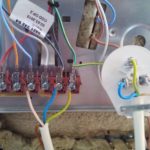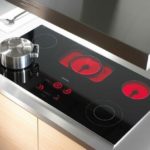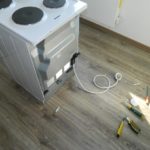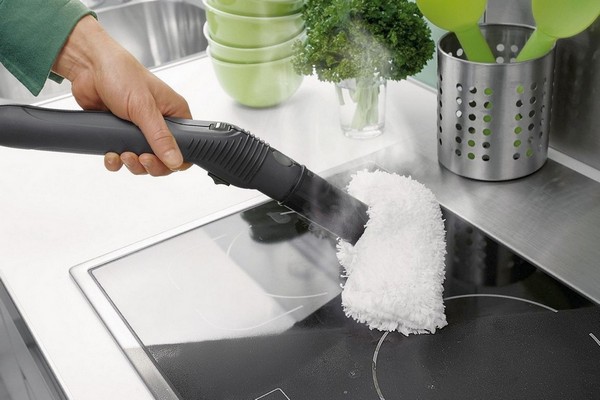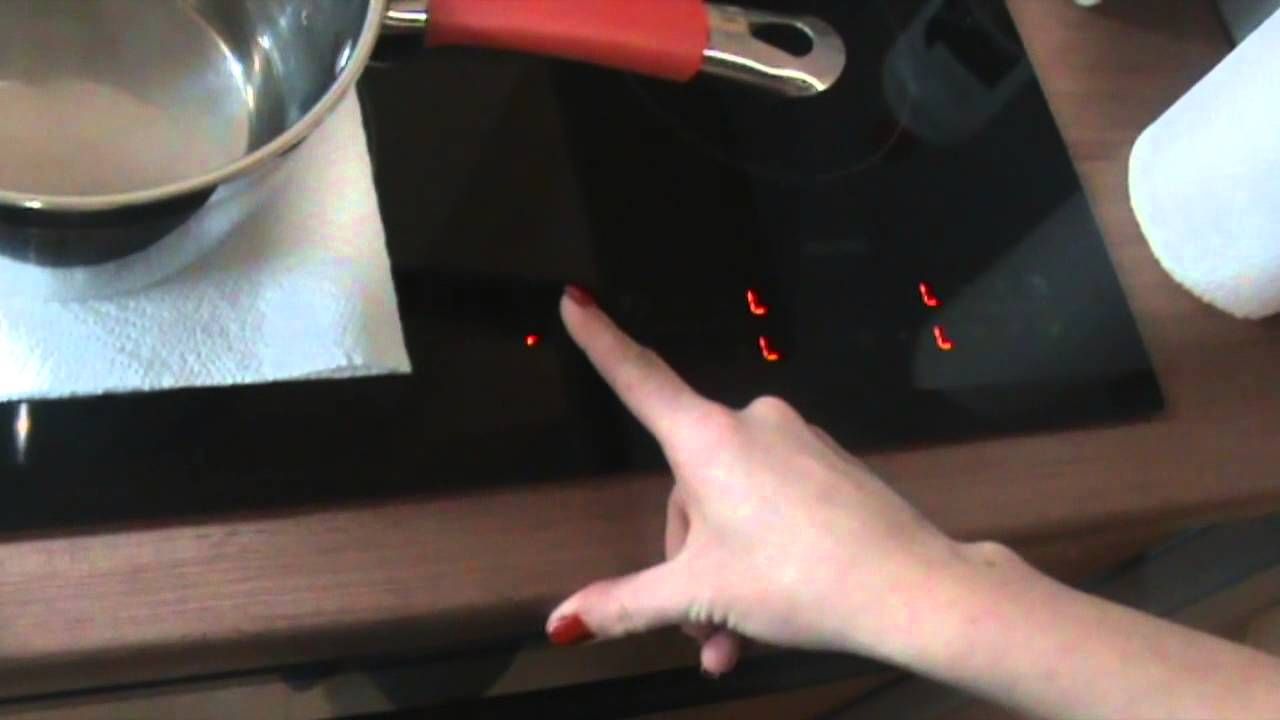Connecting an electric stove
 One of the main attributes in a modern kitchen is the stove. Most modern houses are equipped with electric stoves. These devices are rightfully considered safer than their gas counterparts - they do not use open fire sources and eliminate the risk of explosion or carbon monoxide poisoning. However, they are still a source of increased danger, since they carry the risk of electric shock or fire. For safe operation of the electric stove, it is important to choose the right location and reliably connect it to the electrical network.
One of the main attributes in a modern kitchen is the stove. Most modern houses are equipped with electric stoves. These devices are rightfully considered safer than their gas counterparts - they do not use open fire sources and eliminate the risk of explosion or carbon monoxide poisoning. However, they are still a source of increased danger, since they carry the risk of electric shock or fire. For safe operation of the electric stove, it is important to choose the right location and reliably connect it to the electrical network.
The content of the article
Selecting and preparing a site for installing an electric stove
 Choosing a location is an important step during installation. In order for the electric stove to serve you for as long as possible, and its operation to bring only positive emotions, you must choose the right installation location. It must meet the following requirements:
Choosing a location is an important step during installation. In order for the electric stove to serve you for as long as possible, and its operation to bring only positive emotions, you must choose the right installation location. It must meet the following requirements:
- the floor surface must provide the ability to install the device strictly horizontally;
- There should be no flammable objects in the immediate vicinity (curtains, textiles, plastic panels, etc.)
- the product should not be adjacent to a kitchen sink;
- The minimum distance from the surface of the electric stove to the exhaust hood is at least 45 cm.
REFERENCE! If you are installing an induction model, be aware that it may interfere with nearby electrical appliances.
Primary requirements
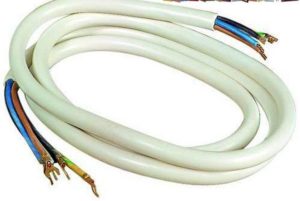 The most critical stage of the installation process is connecting to the electrical network. An electric stove is the most powerful consumer of electricity in an apartment, so connecting it is a responsible matter. If you do not have experience in electrical installation of household electrical appliances, it is better to entrust the installation process to specialists. Incorrect connection may result in electric shock or fire.
The most critical stage of the installation process is connecting to the electrical network. An electric stove is the most powerful consumer of electricity in an apartment, so connecting it is a responsible matter. If you do not have experience in electrical installation of household electrical appliances, it is better to entrust the installation process to specialists. Incorrect connection may result in electric shock or fire.
For those who have basic skills in working with electricity, carrying out the installation process themselves will not be difficult. The main thing is to follow the rules below:
- the electric stove must have a separate underwater cable directly from the electrical panel;
- In the electrical panel for connection, provide a separate circuit breaker, optimally a differential circuit breaker;
- the rating of the circuit breaker must be equal to the maximum current consumed by the electric stove or one step higher;
- cross-section of submarine cable in mm2 you should choose no less than the rated current of the circuit breaker divided by ten;
- Be sure to ensure reliable grounding.
IMPORTANT! If there is no reliable grounding, there is a risk of electric shock when touching metal parts of the housing.
Cable installation
When choosing the cross-section of an underwater cable, many make the mistake of being guided only by data on the maximum current consumed by the electric stove. Ignoring the fact that the cable must withstand a current greater than the rating of the circuit breaker in the panel.
As a cable for connecting household electric stoves, it is most rational to use a flame retardant cable with single-wire copper conductors, for example, VVGng or NYM.
ATTENTION! You should purchase cable only from trusted suppliers. Currently, there is a large number of low-quality cables on the market, whose conductor cross-section and insulation thickness do not correspond to the declared ones.
The cable for the electric stove should be installed together with the rest of the wiring in a hidden way. It should come out of the wall near the installation site of the electric stove.
Stove connection diagram
Models of electric stoves on the market use different connection schemes. It is necessary to take this fact into account when choosing a particular model. Some manufacturers produce devices capable of operating both in a single-phase network with a voltage of 220 V, and in two and three-phase at a voltage of 380 V.
Single-phase connection
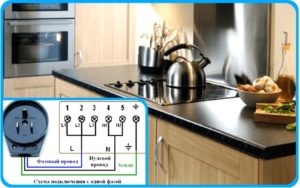 The overwhelming majority of people live in apartments with an electrical network made according to a single-phase circuit with a voltage of 220 V. In this case, the connection of electrical appliances is carried out with a three-core cable, observing the color marking of the cores.
The overwhelming majority of people live in apartments with an electrical network made according to a single-phase circuit with a voltage of 220 V. In this case, the connection of electrical appliances is carried out with a three-core cable, observing the color marking of the cores.
- phase wire white or brown;
- neutral conductor blue;
- the ground wire is yellow-green.
In the terminal block of an electric stove intended for a single-phase network, you can find markings that ensure unambiguous connection of electrical equipment:
- terminal L is used to connect the phase wire;
- terminal N is for neutral;
- PE terminal for grounding.
In universal models, instead of one terminal L, you will find terminals L1, L2, L3, which, when connected, must be connected with standard jumpers supplied with the device in accordance with the operating instructions.
Two-phase connection
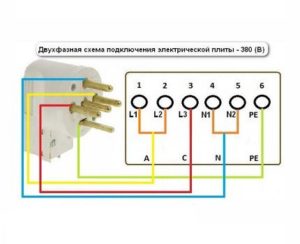 A two-phase connection is a rare option for connecting to the power grid in our country. In a network of this type, the voltage between the neutral conductor and any of the phases is 220 volts, between two phase conductors 380 V. To connect to this network, you need to prepare a four-core cable and a two-pole circuit breaker in the electrical panel.
A two-phase connection is a rare option for connecting to the power grid in our country. In a network of this type, the voltage between the neutral conductor and any of the phases is 220 volts, between two phase conductors 380 V. To connect to this network, you need to prepare a four-core cable and a two-pole circuit breaker in the electrical panel.
Color marking of cores in this case:
- the first phase wire is white or brown;
- the second phase conductor is black;
- neutral conductor blue;
- the ground wire is yellow-green.
ATTENTION! Depending on the type and manufacturer of the electrical cable, the color of the phase conductors may differ, but the color of the neutral and ground wires remains the same.
In the terminal block of an electric stove intended for a two-phase network, you can find markings that ensure unambiguous connection of electrical equipment:
- terminal L1 is used to connect the first phase;
- terminal L2 is used to connect the second phase;
- terminal N is for neutral;
- PE terminal for grounding connection.
Three-phase connection
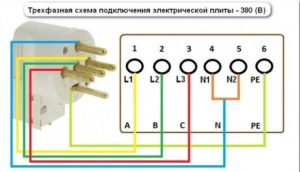 A three-phase network with a voltage of 380 V, as a rule, is available only to owners of private houses. It is the most rational option for connecting electric stoves. When connecting a three-phase network, the load is evenly distributed between the phases, reducing the current consumed by the electric stove.
A three-phase network with a voltage of 380 V, as a rule, is available only to owners of private houses. It is the most rational option for connecting electric stoves. When connecting a three-phase network, the load is evenly distributed between the phases, reducing the current consumed by the electric stove.
In the case of a three-phase network, you need a five-core submarine cable and a three-pole circuit breaker in the electrical panel.
The terminal block of the plate will contain the following terminals:
- terminal L1 is used to connect the first phase;
- terminal L2 is used to connect the second phase;
- terminal L3 is used to connect the third phase;
- terminal N is for neutral;
- PE terminal for grounding connection.
ATTENTION! In electric stoves designed to operate in both three-phase and single-phase networks, jumpers can be located between terminals L1, L2, L3. When connecting to a three-phase network, they must be removed, otherwise a short circuit will occur.
Connecting a stove without an outlet with your own hands
Having familiarized yourself with how the stove is connected to the electrical network, all that remains is to decide on the optimal connection option for your case. Typically, in practice the following three options are used:
- Connection via electrical outlet. The most commonly used option for connecting household appliances, some models of electric stoves come with an electrical cord already connected to the outlet. The difference from other electrical appliances is that it is necessary to use special sockets for powerful consumers. If necessary, the device can be disconnected from the network by unplugging it from the outlet.
- Pconnection via terminal block. The cable from the panel is connected to the cable from the stove in the terminal box located on the wall near the stove. This connection option allows you to use a flexible cable directly to connect the device, providing some mobility during operation. A terminal connection is considered more reliable than an electrical outlet.
- Pdirect connection. A single cable without connections from the shield to the terminal block of the plate.The most preferable option in theory, but difficult to implement in practice in everyday life. It is used when connecting high-power industrial electric stoves.
ATTENTION! Do not use household sockets to connect the electric stove, as they are not designed for a current higher than 16 A, which is not enough for such consumer devices.
As you can see, connecting an electric stove is not much different from connecting other appliances to the mains. If you have some experience, this operation will not be difficult for most home craftsmen.

